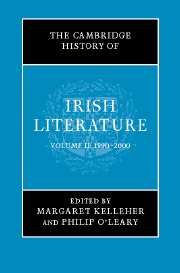Book contents
- Frontmatter
- Introduction
- 1 Literature and politics
- 2 The Irish Renaissance, 1890–1940: poetry in English
- 3 The Irish Renaissance, 1890–1940: prose in English
- 4 The Irish Renaissance, 1890–1940: drama in English
- 5 The Irish Renaissance, 1880–1940: literature in Irish
- 6 Contemporary prose and drama in Irish 1940–2000
- 7 Contemporary poetry in Irish: 1940–2000
- 8 Contemporary poetry in English: 1940–2000
- 9 Contemporary prose in English: 1940–2000
- 10 Contemporary drama in English: 1940–2000
- 11 Cinema and Irish literature
- 12 Literary historiography, 1890–2000
- Afterword: Irish-language literature in the new millennium
- Afterword: Irish literature in English in the new millennium
- Guide to major subject areas
- Index
- References
12 - Literary historiography, 1890–2000
Published online by Cambridge University Press: 28 March 2008
- Frontmatter
- Introduction
- 1 Literature and politics
- 2 The Irish Renaissance, 1890–1940: poetry in English
- 3 The Irish Renaissance, 1890–1940: prose in English
- 4 The Irish Renaissance, 1890–1940: drama in English
- 5 The Irish Renaissance, 1880–1940: literature in Irish
- 6 Contemporary prose and drama in Irish 1940–2000
- 7 Contemporary poetry in Irish: 1940–2000
- 8 Contemporary poetry in English: 1940–2000
- 9 Contemporary prose in English: 1940–2000
- 10 Contemporary drama in English: 1940–2000
- 11 Cinema and Irish literature
- 12 Literary historiography, 1890–2000
- Afterword: Irish-language literature in the new millennium
- Afterword: Irish literature in English in the new millennium
- Guide to major subject areas
- Index
- References
Summary
Making readers
In 1906 D. J.O’Donoghue published The Geographical Distribution of Irish Ability. O’Donoghue was one of the first, and also one of the most energetically patriotic, Irish literary critics of the twentieth century. He is best remembered now, if at all, as editor of the pioneering The Poets of Ireland: A Biographical Dictionary, and for the ease with which Yeats dismissed him as, for example, a man who ‘spoke the most Cockney dialect imaginable’. O’Donoghue’s The Geographical Distribution of Irish Ability is the critical impulse of the Irish Literary Revival run rampant. Using indices and figures, O’Donoghue, as if in deadpan parody of Victorian blue-book statistics, tries to prove that Ireland has more geniuses per head of population than ‘mainland’ Britain. O’Donoghue’s ‘ardour’ in cataloguing and proving Ireland’s literary and cultural worth is the exaggerated epitome of an Irish Revival literary historiography, which was trying to put its foundations in place while the rest of the building was being constructed around it. Perhaps more than any other single critic of the Revival period, O’Donoghue reflects a pervasive anxiety that the weight of the tradition of ‘English’ literature will suppress a nascent Irish writing before it can become fully established. His Poets of Ireland was an argument for an historical and living tradition of writing in Ireland; The Geographical Distribution of Irish Ability tips the scales further towards Ireland by reclaiming Irish roots for many ‘English’ or ‘British’ cultural achievements (Sheridan’s plays, for example). Such cultural politics are understandable in their context – Robert Crawford’s Devolving English Literature (1992), arguing that the idea of ‘English’ literature has Scottish intellectual origins, could be said to stand in the same conceptual relationship to late twentieth-century Scottish devolution as O’Donoghue’s book does to the early twentieth-century cultural-nationalist argument for Irish independence.
- Type
- Chapter
- Information
- The Cambridge History of Irish Literature , pp. 562 - 599Publisher: Cambridge University PressPrint publication year: 2006
References
- 2
- Cited by

